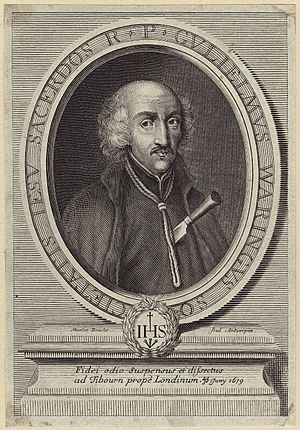William Barrow (Jesuit) facts for kids
Quick facts for kids BlessedWilliam Barrow SJ |
|
|---|---|

Portrait of William Barrow, SJ by Cornelis van Merlen
|
|
| Martyr | |
| Born | c. 1609 Lancashire, England |
| Died | 20 June 1679 (aged 69 - 70) Tyburn, London, England |
| Honored in | Roman Catholicism |
| Beatified | 15 December 1929 by Pope Pius XI |
| Feast | 20 June |
William Barrow (also known as Waring or Harcourt) was an English Jesuit priest. He was born around 1609 and died on June 20, 1679. Barrow was executed because of something called the Popish Plot. This was a made-up story that caused a lot of fear and anger against Catholics in England and Scotland between 1678 and 1681. William Barrow is honored by the Roman Catholic church as a martyr, which means someone who died for their faith. He was officially recognized as "Blessed" in 1929.
Contents
William Barrow's Story
Early Life and Priesthood
William Barrow was born in a place called Lancashire, England. He went to school at the Jesuit College, St. Omer's. This was a special school for young men who wanted to become Jesuits. In 1632, he joined the Society of Jesus, which is a religious group of priests and brothers.
After his training, William Barrow was sent to England in 1644. For 35 years, he worked as a priest in the London area. By the beginning of 1678, he had become the leader of the Jesuits in London.
The Popish Plot and Arrest
In 1678, a man named Titus Oates made up a story about a "Popish Plot." He claimed that Catholics were planning to kill King Charles II and take over the government. This story caused a lot of panic and fear across England.
Because of this plot, William Barrow became one of the people the government was looking for. He used a different name, Harcourt, which made it hard for them to find him at first. He hid in London for several months. But in May 1679, he was finally arrested. He was sent to Newgate prison, accused of being part of the made-up plot.
The Trial and Execution
William Barrow's trial began on June 13, 1679. He was tried with four other Jesuit priests: Thomas Whitebread, John Fenwick, John Gavan, and Anthony Turner. The main people who spoke against them were Titus Oates and two other men, William Bedloe and Stephen Dugdale.
The priests were accused of planning to kill King Charles II and change England's religion from Protestantism back to Catholicism. They tried to defend themselves by bringing their own witnesses. They also asked tough questions to their accusers. The judge, Lord Chief Justice Scroggs, told the jury not to believe any Catholic witnesses. He said that Catholics might have been given permission to lie.
William Barrow and the other priests were found guilty. They were sentenced to death for what was called "high treason." This was a very serious crime against the King and country. They were executed together on June 20, 1679, at a place called Tyburn in London.
King Charles II knew that the priests were innocent. As a kindness, he ordered that they should not suffer the full, harsh punishment for treason. Instead, they were given a proper burial. Many people in the crowd watched quietly as each man said he was innocent. This showed that people were starting to doubt the Popish Plot. The priests were buried in St Giles in the Fields.
Beatification
Many years later, on December 4, 1886, the process began to officially recognize William Barrow as a martyr. This process is called "beatification." He was officially beatified as "Blessed William Harcourt" on December 15, 1929, by Pope Pius XI.

